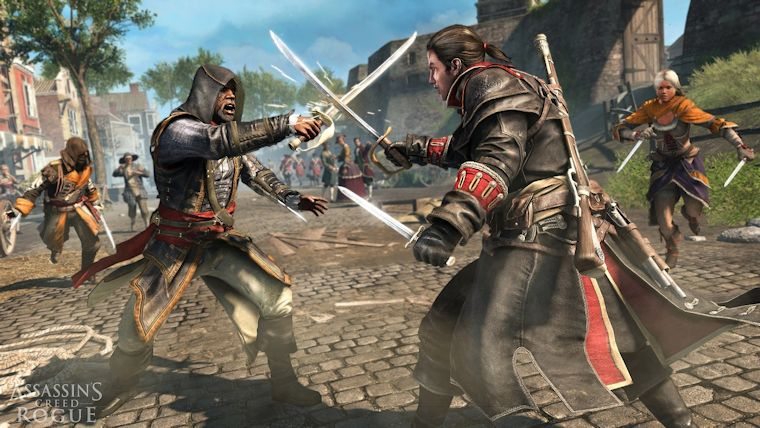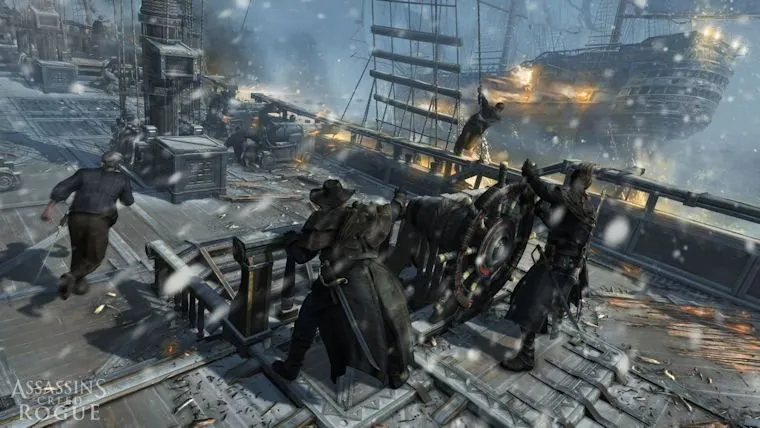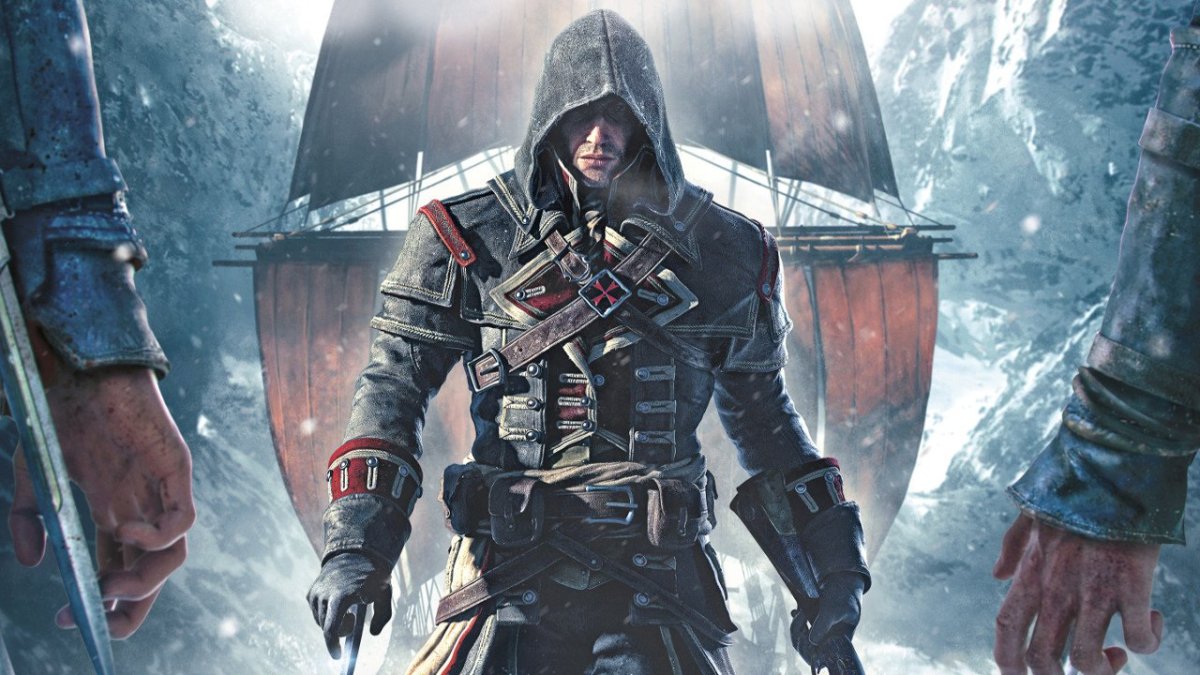After debuting in 2007, the Assassin’s Creed series quickly became one of Ubisoft’s most prominent money makers by mixing historically rich stories with addictive gameplay. Assassin’s Creed Unity already released last week on current-gen systems, resulting in much more promotion from Ubisoft. However, the overlooked Assassin’s Creed Rogue also had its debut on the same day, this one exclusive to last generation consoles. Unlike the new territory brought forth by Unity, Assassin’s Creed Rogue is a culmination of many of the best elements of the recent Assassin’s Creed games, with a twist in the story that shakes the very foundation the series rests upon.
The Assassin’s Creed series has offered a variety of different stories over the years, but Rogue offers one of the most ambitious yet. Outside of a few instances, the Assassin’s have always been propped up as the heroes while the Templars are the evil false prophets that must be stopped at any costs. However, Assassin’s Creed Rogue turns the formula on its head by giving the player control of an Assassin named Shay, who begins to question his cause, eventually turning to the side players had previously seen as only the antagonists.
The writers could have easily just decided to make a game with an evil protagonist who serves to fight the good guys, but instead they chose to aim for the morally grey area, which is new territory for the series. This storyline also carries over to the future segments, but they continue to remain rather dull most of the time.
This all results in Assassin’s Creed Rogue having one of the most compelling stories in the series, but it is held back by its shorter length. Rather than the usual 11 or 12 sequences found in most entries in the series, Rogue only has 6, though some of the sequences feature more memories than those in the past. Despite this, the ending is far from abrupt, with plenty of setup and hints that the player is nearing the end, but it still seems like it ends just when the story is getting really good, leaving the story of Shay sadly unexplored as fully as it could have been.

There have been complaints about the lacking protagonists throughout the history of the Assassin’s Creed series, but Shay manages to stand out from the crowd with a major focus on his internal dilemma. The supporting characters also serve as excellent foils for him, including those in both the Assassins and Templars camp. While he does not live up to the series highpoint of Ezio, Shay is still a very competent and intriguing protagonist as he is forced to make many difficult choices.
Unlike the Caribbean setting in Black Flag, Assassin’s Creed Rogue returns to the northeast, as Shay explores locations like New York, Albany, and more. Moving back to North America allows for more recognizable characters in US History to play a role once again, with Benjamin Franklin even playing a part in the ongoing story of the game. Serving as a prelude to III, Rogue sets up many of the storylines that eventually unfold as part of Connor’s journey. Interestingly, seeing the game from the eyes of a Templar really puts a spin on everything the player has learned in the past, including the usage of what were previously thought to be real life natural disasters as a platform for their movement.
The game also has a much larger sea to navigate than III, but is rather comparable to Black Flag, though it is split into a few different locations instead of one large map. Many of the locations are uninspired in design, but there are some standouts like Sleepy Hollow, which even includes the infamous bridge from the story. The snowy setting of Assassin’s Creed III was a really nice change for the series and it was great to see Shay return to that type of setting, rather than the tropical climates of Black Flag.

Most of the environments in Rogue look gorgeous, with the snow covered land and sea standing out the most. There was no way the game was going to match up with Unity, but to be able to go back from playing current-gen games to Rogue without it feeling incredibly jarring, really is a testament to how impressive the games looks. Hopefully it may see a port to current-gen at some point, similar to Liberation last year, so it can reach its full potential.
From the mountains to the open sea, the snow and ice are very prominent throughout most of the game. However, there are occasionally some technical hiccups where Shay falls through the snow as if it wasn’t there. Thankfully the snow battles in the sea really do help to make up for any problems with the setting otherwise.
Assassin’s Creed Rogue brings back many of the best elements of III and Black Flag
The return of the cold weather locations even brings back the freezing mechanic, which keeps the player out of the water for most of the game. This means one will have to be a little more strategic when escaping from enemy groups, instead of just being able to swim away. As a result, the dive sites found in Black Flag are not in the game, though the return of ship battles was the much more important aspect.
Assassin’s Creed III first debuted the naval warfare mechanic, albeit in a limited setting, but Assassin’s Creed IV: Black Flag took it to an entirely different level. Not only focusing the game around it, Black Flag expanded upon the gameplay as a whole with plenty of new features. The latter’s level of complexity returns in Assassin’s Creed Rogue, though not expanded upon for the most part.
Replacing the Jackdaw is the Morrigan, the new vessel for Shay as he sales across the northeast. The upgrades seemed to be more prevalent in Rogue, with money being much more accessible than in Black Flag. The cargo that is required to upgrade the Morrigan can still be a pain to find and plunder, but the missions were a breeze compared to many in its predecessor. In fact, the only mission that put Shay in a major predicament on the seas found him temporarily in control of a much more powerful ship, which was near indestructible and had immense firepower. If the player starts to gradually upgrade as he or she goes, there should be little in the way of concern, outside of maybe the final memory on the seas.

While Assassin’s Creed Rogue brings back many of the best elements of III and Black Flag, the biggest problem alongside the short length is that Ubisoft seemingly played it extremely safe gameplay-wise. Outside of the addition of the new air rifle, which works as a more efficient way to use darts, and the grenade launcher, there is almost nothing to differentiate the gameplay from what has been found in the series for awhile now. The current setup allows the player to easily play the game with the most basic sword, without ever needing to upgrade. Just like how the Morrigan needs to be upgraded to be victorious in battle, the combat system really needs to be overhauled in a similar fashion.
The Verdict
Assassin’s Creed Rogue is an exceptionally ambitious project that turns the story that the player knows thus far on its head. Previously thought to be a simple battle of good versus evil, the Templars are now presented as the protagonists that are trying to stop the Assassins from destroying the world. However, the rather short campaign is still riddled with uninspired gameplay that has started to become relatively stale. Assassin’s Creed Rogue may be overshadowed by its current-gen counterpart, but with one of the most unique storylines in the series, it is worth playing for that very reason.











Published: Nov 17, 2014 05:16 pm